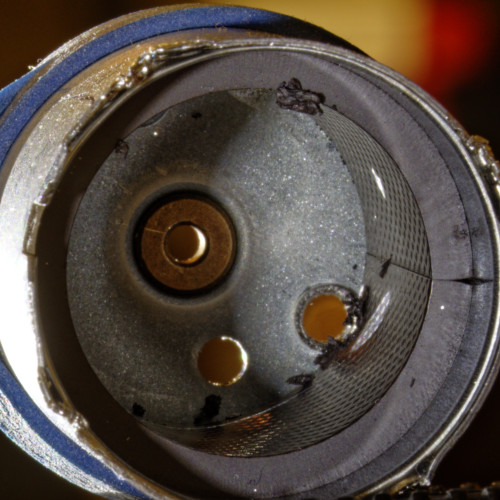|
Author
|
Topic: Review Wolverine Reels2Digital MovieMaker 8mm film digitizer
|
|
|
Mike Spice
Master Film Handler
Posts: 421
From: none of your business
Registered: Jun 2017
|
 posted October 29, 2019 02:26 AM
posted October 29, 2019 02:26 AM



The idea of the sprocket/capstan does seems like a good idea for those who want to scan films and leave the machine to it, but it does raise a couple of things for me personally.
You will find settings need changing during a scan....
Having scanned around 900ft now, I have had the odd splice and frame that got stuck, as I baby sit each scan, it was quick to correct, but in the final image sequence I did get static frame for a second.
Also by baby sitting, I don't have to rely on auto exposure, I can change settings scene to scene.
Gamma, exposure, gain, hue can all be adjusted during a baby sitting scan, from scene to scene.
I wouldn't like to have to do that in post.
Every reel I have done so far, I have changed settings scene to scene.
If a 400ft reel was scanning unattended, you wouldn't know about stuck frames until you had rendered out the sequence and would then have to trawl through literally thousands of stills to find the stuck frames to delete and re render.
Hugely time consuming..... given how many stills are generated.
Some of my reels, in excess of 7000 stills, and I haven't done a 400ft yet.
You are going to need a program to let you scroll through thousands of thumbnails quickly and efficiently that will also batch rename.
I use Faststone which is very easy to use, it also has a batch re numbering tool, which is very very useful.
If you have to delete static image files, where the film stuck, bear in mind the entire sequence of images will need to be renumbered from beginning to end, or your software will only load up to the point the number sequence breaks.
Also bear in mind, each scan needs the #number and name changing before scanning, or the IC software will end up numbering and naming images from where the last scan left off.
Something to think about, and consider how your work flow will develop.....
In other news.
I discovered that the IC software sometimes hangs at the splash screen with the camera connected.
Easy fix turned out to be, start IC capture without the camera, when it gets to the point where it says it can't find a device, plug in the camera, it will appear in the device window and away you go.
[ October 29, 2019, 08:38 AM: Message edited by: Mike Spice ]
| IP: Logged
|
|
|
|
|
|
|
|
Mike Spice
Master Film Handler
Posts: 421
From: none of your business
Registered: Jun 2017
|
 posted October 29, 2019 11:04 AM
posted October 29, 2019 11:04 AM



I would speak to Robyn by phone, she is most helpful, and email the photo to them.
DO NOTHING TO IT UNTIL YOU SPEAK TO THEM and they have seen the photo, perhaps take a couple more, from a different perspective, up close.
They wouldn't know, as the sensor is wrapped in light proof plastic and can't be seen.
01590 679333
in other news, HAWKEYE modders
I have come to the conclusion that if anyone doing the Hawkeye mod thinks they can set up a reel of film to scan, and walk away leaving everything on automatic and get a good scan?
It is not going to happen.
The more I scan, the more I learn.
Automatic scans are a thing of the past, once the mod is done.
That is a good thing, but you're going to have to find the time to baby sit reels...
I am happy to be proved wrong, but I don't think I will be..
I am having so much fun clicking exposure and gamma and contrast as every single frame passes under the camera.
Today's scan was a mess, I hope Weds scans will be better.
[ October 29, 2019, 02:56 PM: Message edited by: Mike Spice ]
| IP: Logged
|
|
David Brown
Film Handler
Posts: 42
From: Centerville, UT, USA
Registered: Oct 2019
|
 posted October 29, 2019 11:53 AM
posted October 29, 2019 11:53 AM




STAN
My motor did not come with and screws or wiring! I had some long 3mm screws and had to cut them down. The motor was completely mounted in the Wolverine when I applied power and the screws could be the problem. The shaft was very difficult to rotate before I mounted it, I will pull it out and test it without screws.
Thanks Kamel , I remember seeing the capstan wiring now. At the time I thought I would need that when connecting up the circuit board and didn't focus on the motor pinout descriptions.
I'm not able to give you feedback on the 8mm cogs yet. I had a difficult time printing it. The best one has very short pins, so I'm going to order those from Thingyverse. I'm using PLA and don't expect to jump into ABS anytime soon at home.
Thank you for the pulley designs. I have tried to print 8mm pulleys long before this project and had some success, yours are very strong and freely rotate. I've replace all the Wolverine pulleys and may need to add more with the external winders I've printed from Thingyverse. I'm now able to use 800 foot reels, if they were shimmed up and inch or so I could use 1200' reels. Don't see a lot of those, I only have one.
HOWEVER, That brings to mind Mike's case for doing scene by scene captures. If the final capture is important, you must spend time reviewing the finished product. The time spent re-mounting the film, FINDING the problem scene....
I've done that! It takes too much time. The larger the reel, the greater variety of exposure settings.
I don't know what capacity the IC has for setting white balance manually. I suggest always white balancing the light source. Do it before any film is loaded. I have been capturing 8mm stills for some time now. I've used flash, incandescent, and led. Auto white balance in the camera is not always exact. Using auto white balance in post can work, but there's less color headroom available in a jpeg to change colors. BMP or TIFF have more, but are only 8bit. The best results I've had is with matching the light source in advance. Some times the film will go beyond normal colors, some shots are indoors with daylight film and vice versa. If your light source is balanced in camera, these are easier to correct.
The capstan might cause a problem (running nonstop) during an intentional capture stop? Another switch on the panel? I think the capstan will react faster to get the film moving again than I will. That's with torn sprockets, not sure about a bad cement splice on the left side of the gate. Check for those when cleaning.
| IP: Logged
|
|
Mike Spice
Master Film Handler
Posts: 421
From: none of your business
Registered: Jun 2017
|
 posted October 29, 2019 12:00 PM
posted October 29, 2019 12:00 PM



The only auto setting I am using is white balance, everything else I am adjusting scene by scene.
Auto white balance seems to be doing a great job.
Much better than I can do by mouse clicks.
Auto exposure is a NO NO as the square of white LED light thro' the sprocket hole will misguide the camera in dark scenes.
My reels will get many scans until I perfect the art of a single exposure click, or gamma correct.
Early days of cine film scanning frame by frame.
This is not Wolverine 'pop on a reel and leave it' and then show Aunty Joan her memories on your macbook....
This is the Holy Grail of frame by frame to still image.
My settings are very important now, in a way I never even begun to realise when 'James Stanley Bond Jelavic' came along with his amazing mods.
One good thing, you get plenty of exercise jumping up and down to go click the mouse!
It is a hugely time consuming project, so if you want auto everything.... send your reels to a scanning house.
I have been a sound engineer for some 30 years, I know that I need to get the best sound at the point of recording with my microphone, before I mix it.
I am now learning very quickly the same is true with capturing still images to process to video files.
A radio shack PZM microphone will perform really well, if you place it correctly in the first place.
The same is true with an accurate camera pointed at some cine film.
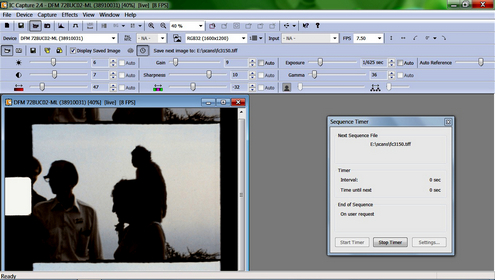
If you are considering, or doing The HAWKEYE MOD
Invest in some memory cards.
Don't use your hard drive.
If you must use it, empty the trash, defrag your drive once a week minimum
You can move to another machine with flash memory, mid scan, for a quick test render with one card, pop in another 'same name' card and carry on scanning....
Writing tiff images to card is much better than writing them to a spinning disk ..
Where we have come to with digital storage is simply incredible. 128Gb on something the size of a postage stamp.
One thing this process has taught me. live preview screen with a reliable picture, is Paramount.
If your preview screen is pants, your scans will be pants.
I have to find some kind of test image to put on my Sony tv, to try and calibrate some kind of balance.
Today's scan was very poor.
Nothing more than my preview screen not telling me the truth.
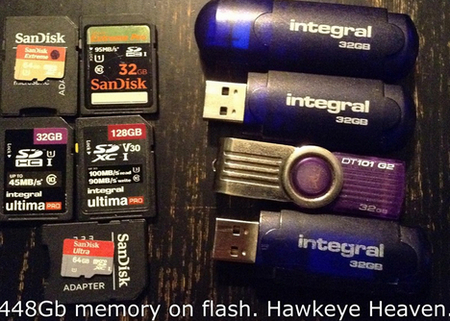
Tuesday scanning....
I scanned 150ft feet today. Disaster.
[ October 30, 2019, 04:53 AM: Message edited by: Mike Spice ]
| IP: Logged
|
|
|
|
|
|
|
|
|
|
|
|
|
|
|
|
|
|
Mike Spice
Master Film Handler
Posts: 421
From: none of your business
Registered: Jun 2017
|
 posted October 30, 2019 08:18 AM
posted October 30, 2019 08:18 AM



Thanks to David for the black and white test image.
My screen did need a little brightness to see all the bars.
I probably won't scan until Friday, when I will find out how it affects my preview screen.
---------------------------------------------------------
The fact you couldn't pause a wolferine scan without getting ghosting really annoyed me.
Hawkeye stills are such a blessing.
You could never pull a still from a Wolferine scan.
A wolf in sheeps clothing......
---------------------------------------------------------
Here is my Wednesday top tip for VirtualDub users.
So, you loaded in 7000 images to make a video.
Perhaps you want to export segments of the sequence.
I know I do, quick test render, without having to export the entire sequence for example.
A clip for social media perhaps.
Once you have set frame rate, crop, compression:
Find the segment you want and then choose 'select range' from the video menu.
When you save the video, it will just save that part of the sequence.
Very handy.
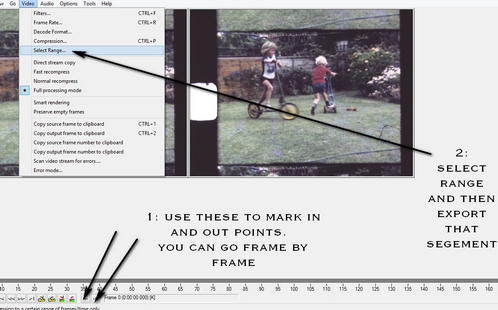
[ October 31, 2019, 11:17 AM: Message edited by: Mike Spice ]
| IP: Logged
|
|
|
|
|
|
|
|
|
|
|
|
|
|
|
|
Mike Spice
Master Film Handler
Posts: 421
From: none of your business
Registered: Jun 2017
|
 posted November 03, 2019 02:31 AM
posted November 03, 2019 02:31 AM



I am really struggling to get consistent scans.
Auto exposure is just not going to work, partly because it's reaction time is so slow, the moment is over before a change has happened, the light from the sprocket is having an effect in dark scenes and in light scenes the auto focus in just not responding how I would imagine it to.
..
Using manual exposure is almost impossible for the scene at the moment,
How did the wolverine manage to make it look so well exposed?
I am trying to scan a scene shot with bright sunlight and darker foreground, all I can get get it either a bleached out sky or a foreground so dark the detail is gone.
I have tried with manual gain and auto gain, manual exposure and auto exposure.
The wolverine managed to expose this with great clarity.
I use Gamma and exposure to try and make it look nice but just keep stalling.
Trying to scan a very dark scene all I ended up with by increasing exposure manually was to have light bleed in the edge of the frame from the sprocket hole.
I also notice the back light control is not active and I can't seem to make it active, greyed out.
I would be interested to know how other folk are coping.
Evenly lit scenes are no problem, they come out very nice
here is an example of trying to capture a very dark scene, to increase exposure and this is what I get.
edit I spoke of auto focus in this post, I meant auto exposure. I haven't deleted it as it gets mentioned in the next page.

[ November 04, 2019, 10:12 AM: Message edited by: Mike Spice ]
| IP: Logged
|
|
|



 UBBFriend: Email this page to someone!
UBBFriend: Email this page to someone!
 Printer-friendly view of this topic
Printer-friendly view of this topic




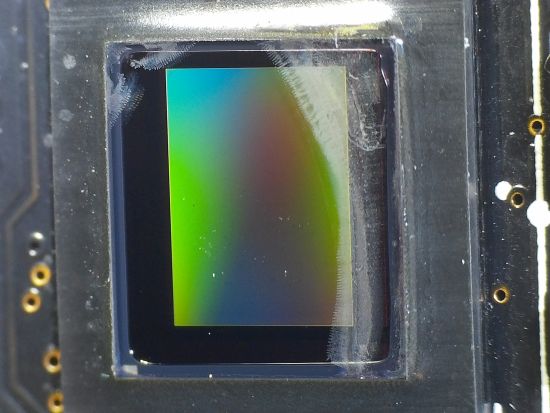


![[Confused]](confused.gif)

